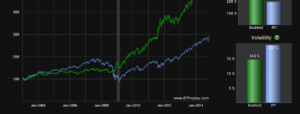Dividend investors are very nervous these days. They watch the troubles at Kinder Morgan (NYSE:KMI) and other oil pipelines, companies that promised huge dividends and now can’t deliver. They wonder if there is any safety for their type of investor.
For such people, there is AT&T (NYSE:T). AT&T pays a steady, and rising dividend. More importantly, it can currently afford that dividend.

The question, as always, is how hard the assets have to be worked in order to pay that dividend, and there is good news on that front, in the recently-completed acquisition of DirecTv. DirecTv added substantially to the asset base, but AT&T’s debt-to-assets ratio actually fell slightly when the deal was completed.
AT&T puts out a lot of press releases about “ultrafast” and “Gigapower” service in various locations, but the real business here is wireless. Along with Verizon (NYSE:VZ) it dominates the U.S. wireless market. That’s where the bulk of the profits come from, that’s what your dividend is paid on.
The rest is a problem.
DirecTv added about $6 billion in sales and $500 million in net income when it came onto the books in the third quarter, but it also added about $75 billion in assets with just $14 billion in long-term debt. DirecTv also gives AT&T a “bundle” it can offer to match what cable television offers, enabling it to focus its wires on Internet service.
Cable has been a growing problem for phone companies like AT&T for decades, because the wires it installed at homes are bigger, capable of handling a lot more data as fiber cable is looped closer-and-closer to neighborhoods. Phone networks, by contrast, have very thin wires and are architected as multiple long loops from central switching stations. The stations are closer to the home, but the wire has to be replaced entirely by fiber or the Internet speed is just not competitive.
AT&T has been working to boost the speed of its Digital Subscriber Line or DSL Internet service, which generally degrades with distance from a switch. The hope is that by using bits for all of a line, making telephony a low-bandwidth digital service, and by using a new Broadcom (NASDAQ:BRCM) technology called G. Fast, these lines can be upgraded without the high cost of running fiber. Meanwhile, the company is advertising its limited number of fiber builds, doing an initial marketing sweep, and then keeping quiet. The cost is prohibitive, and the builds are mainly PR.













Leave A Comment